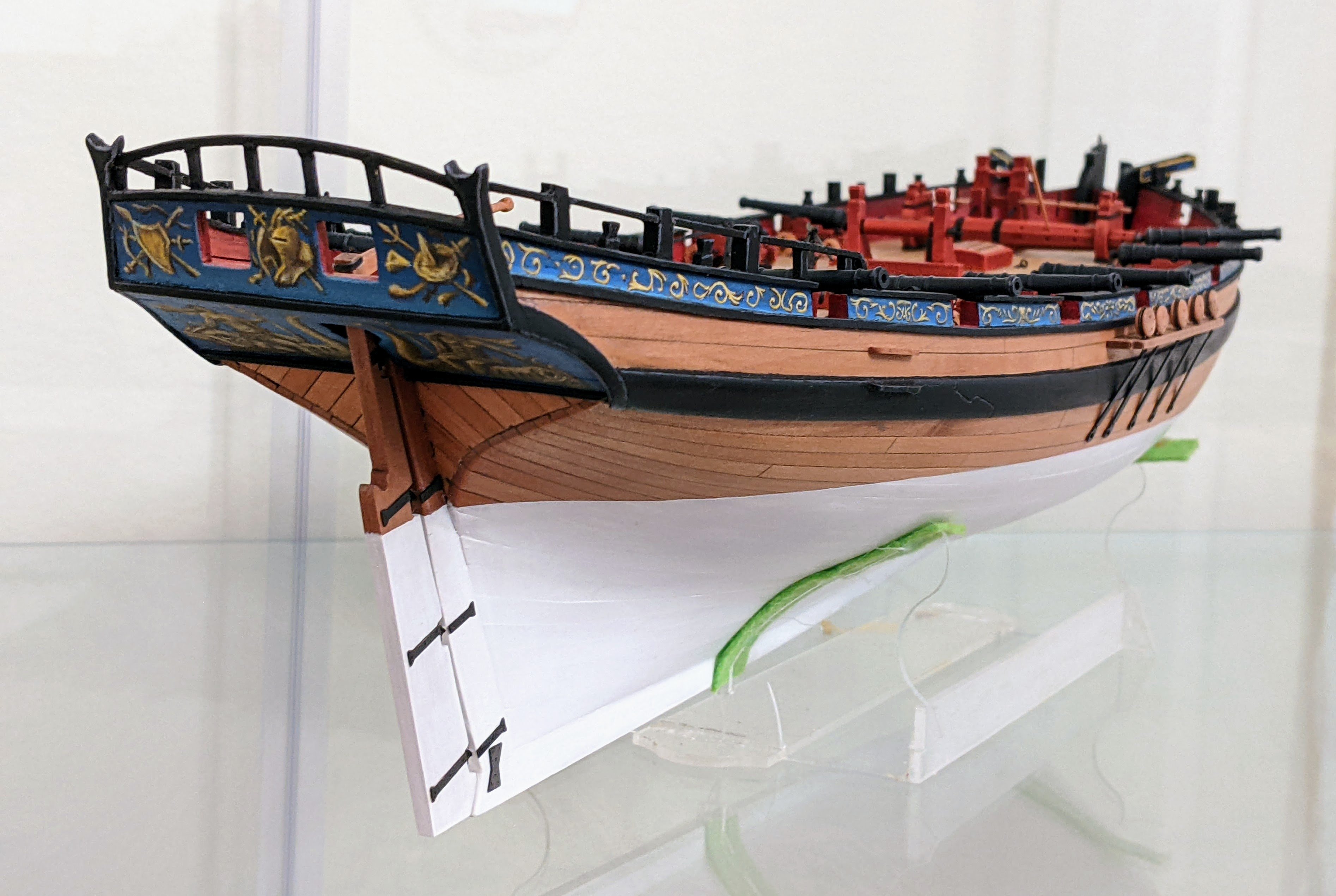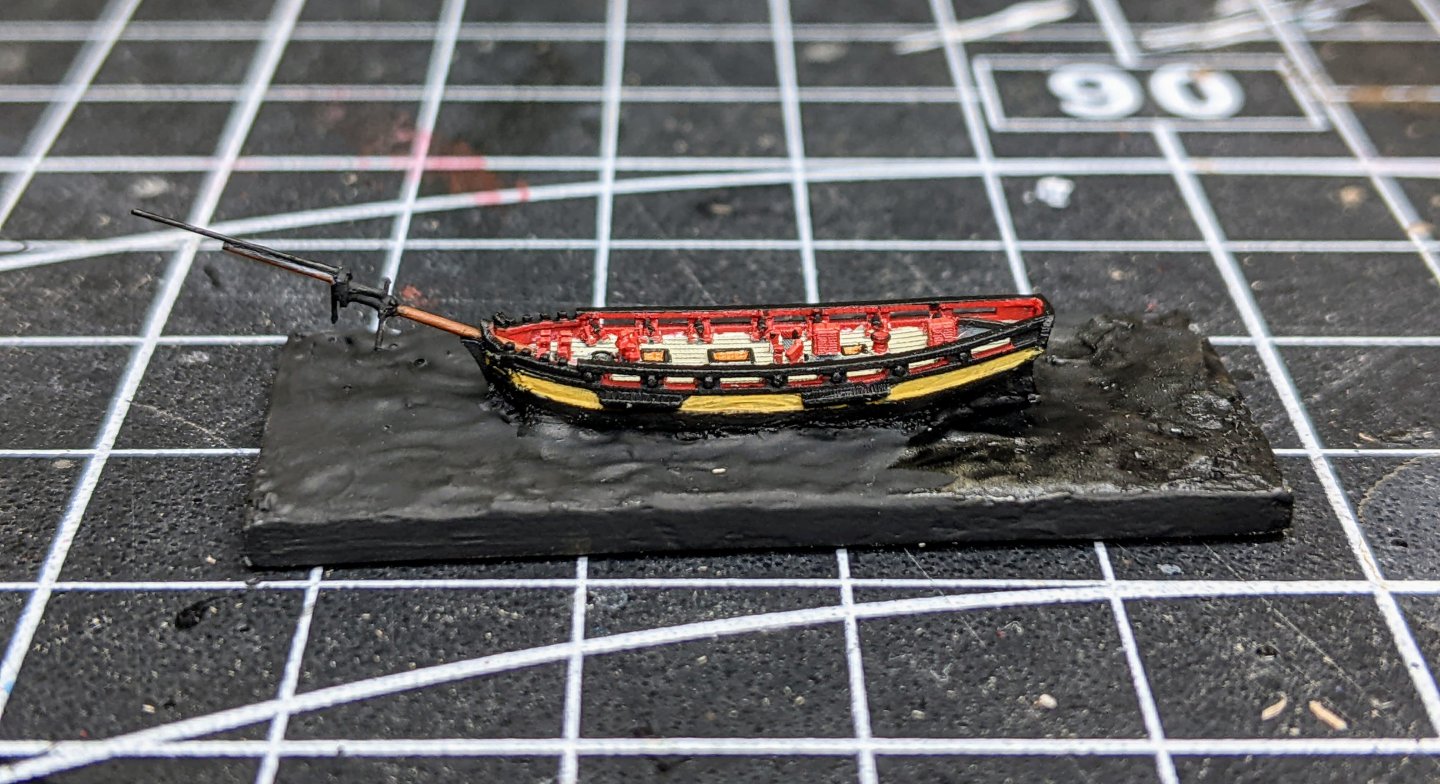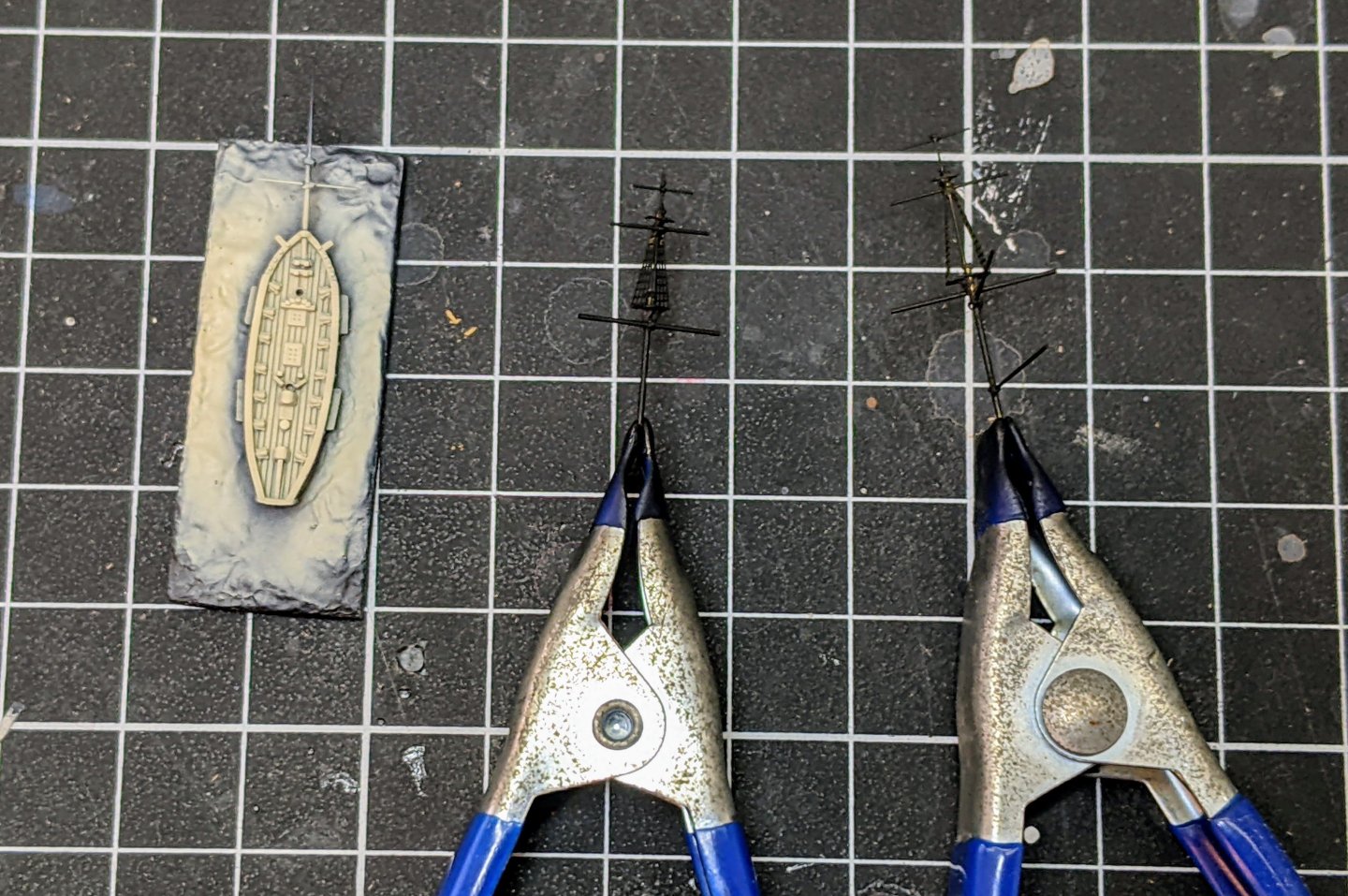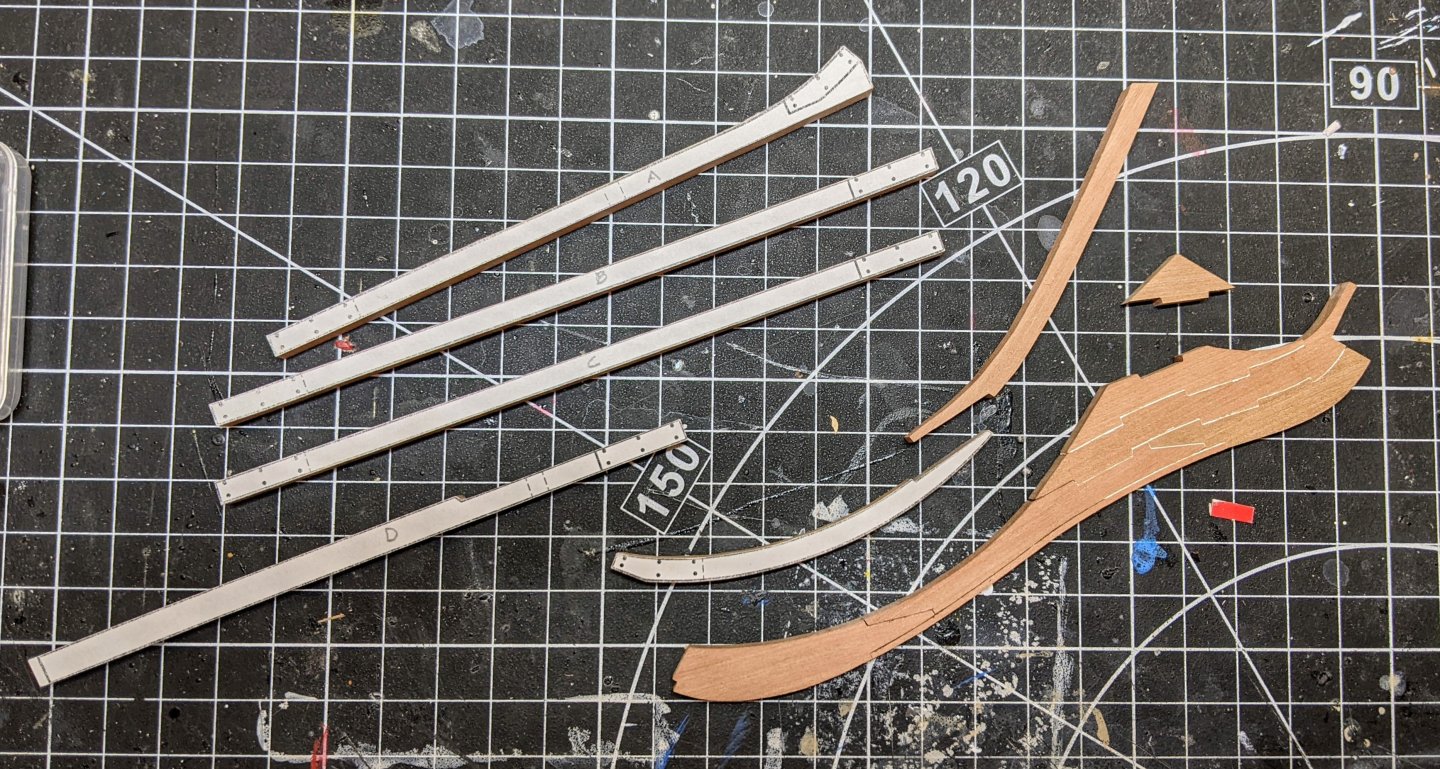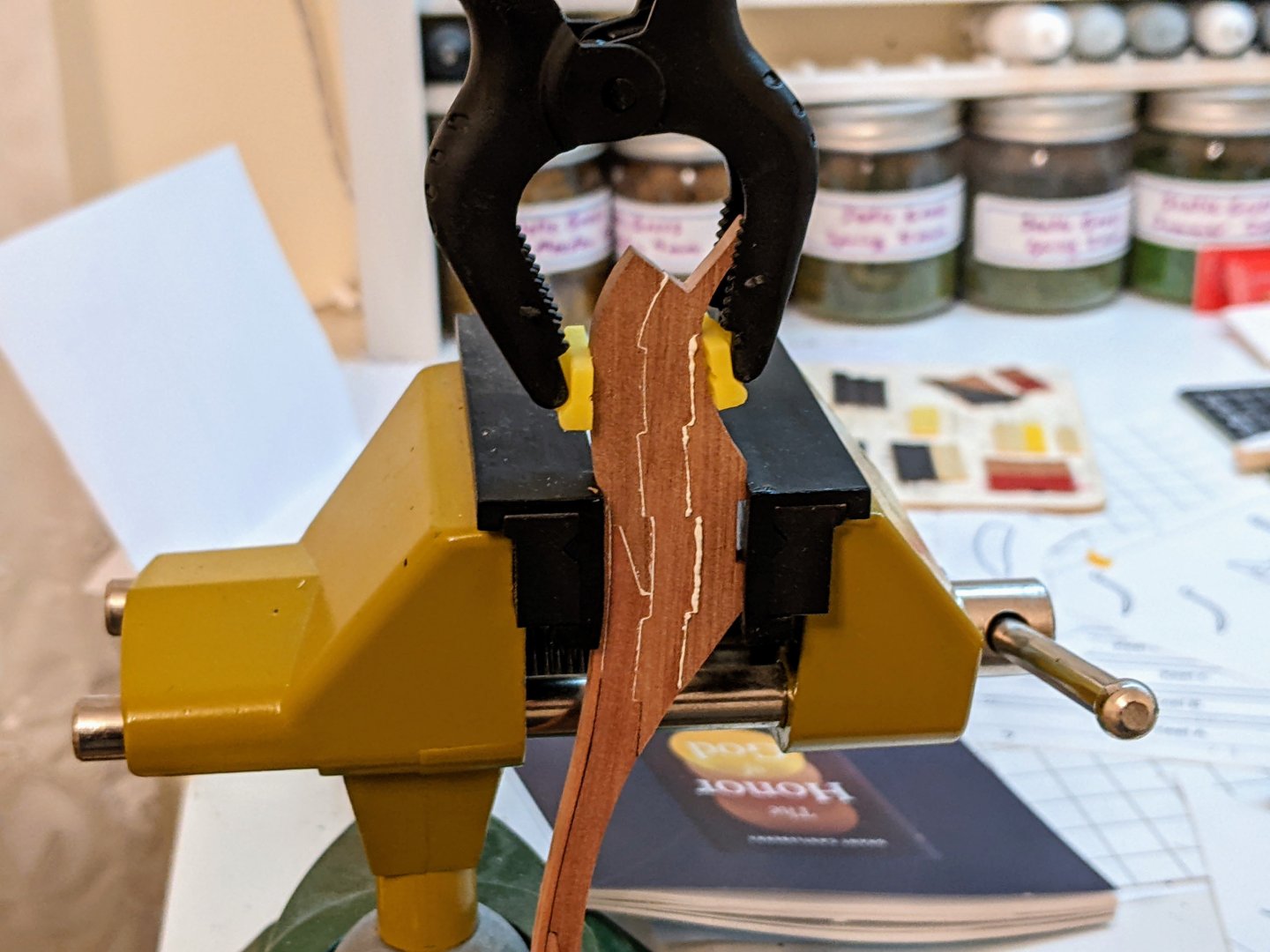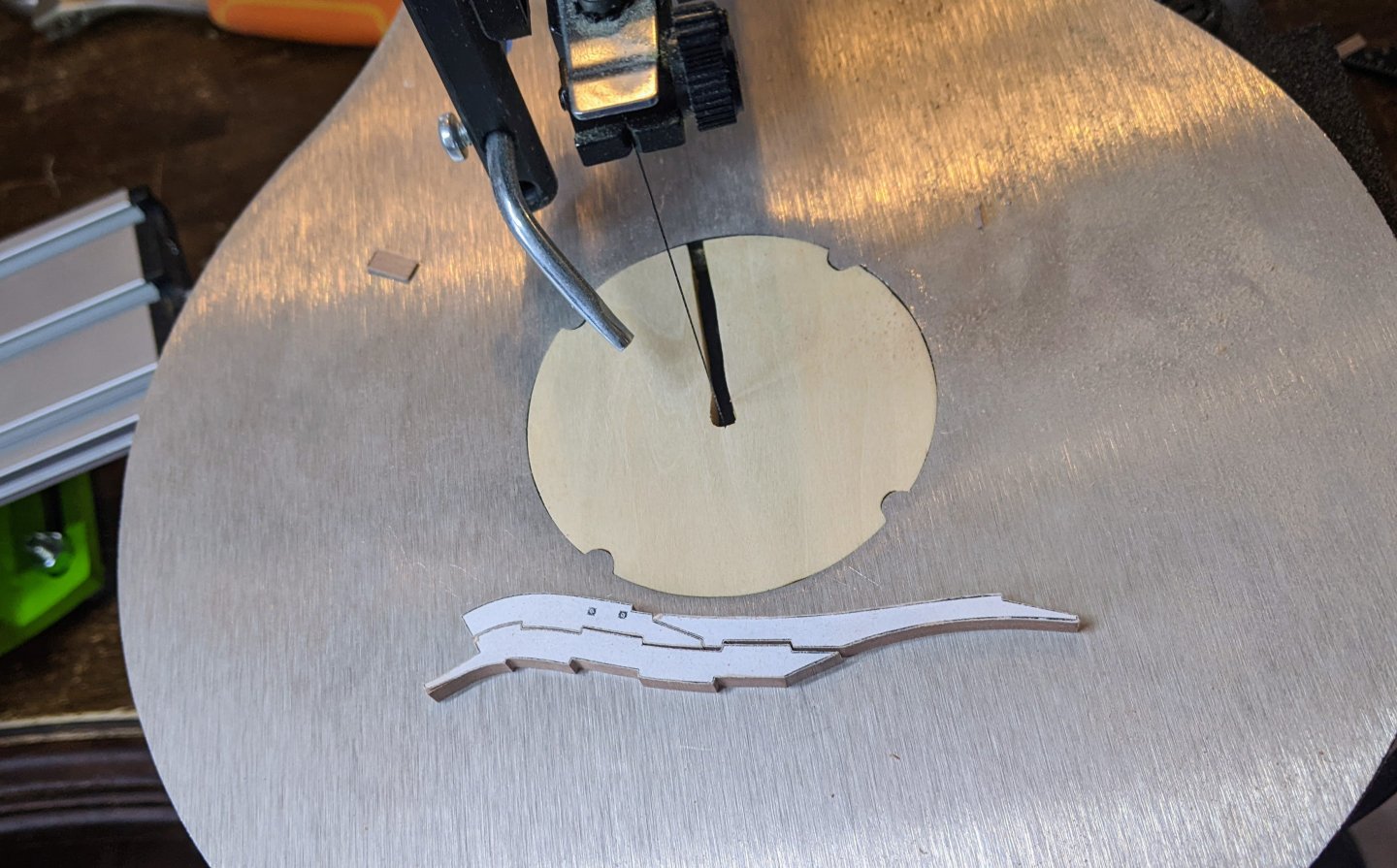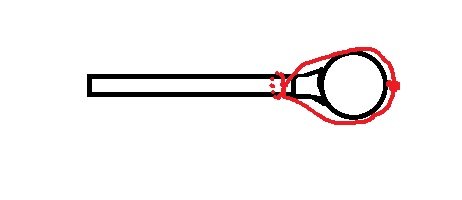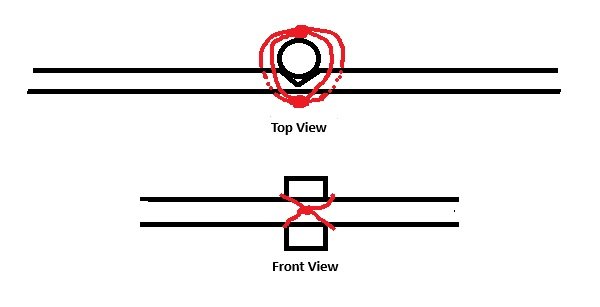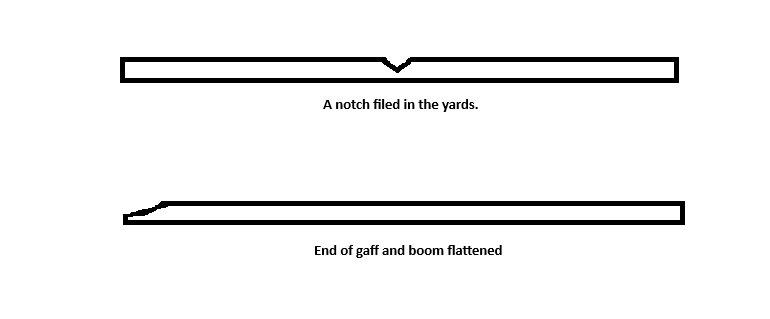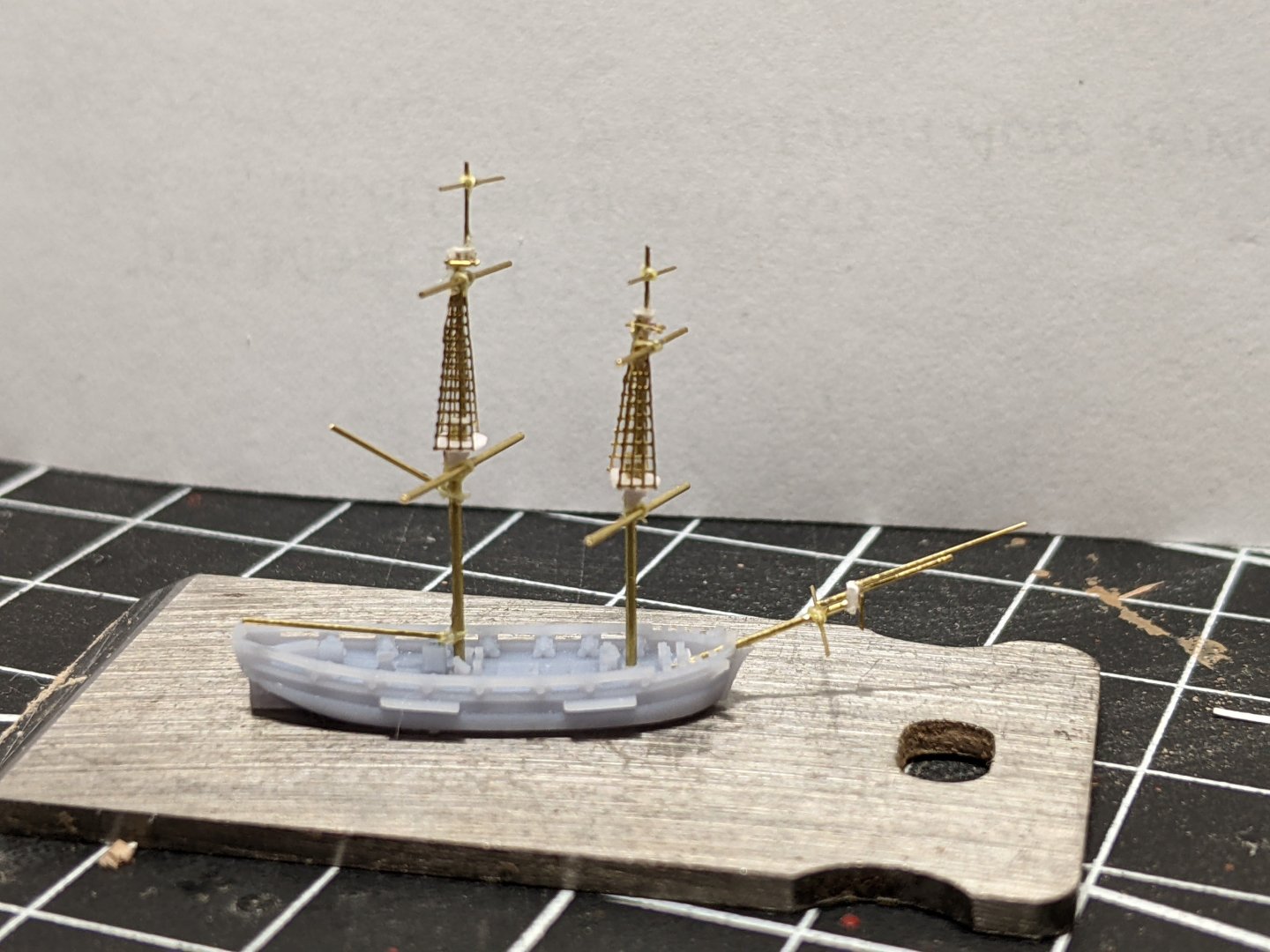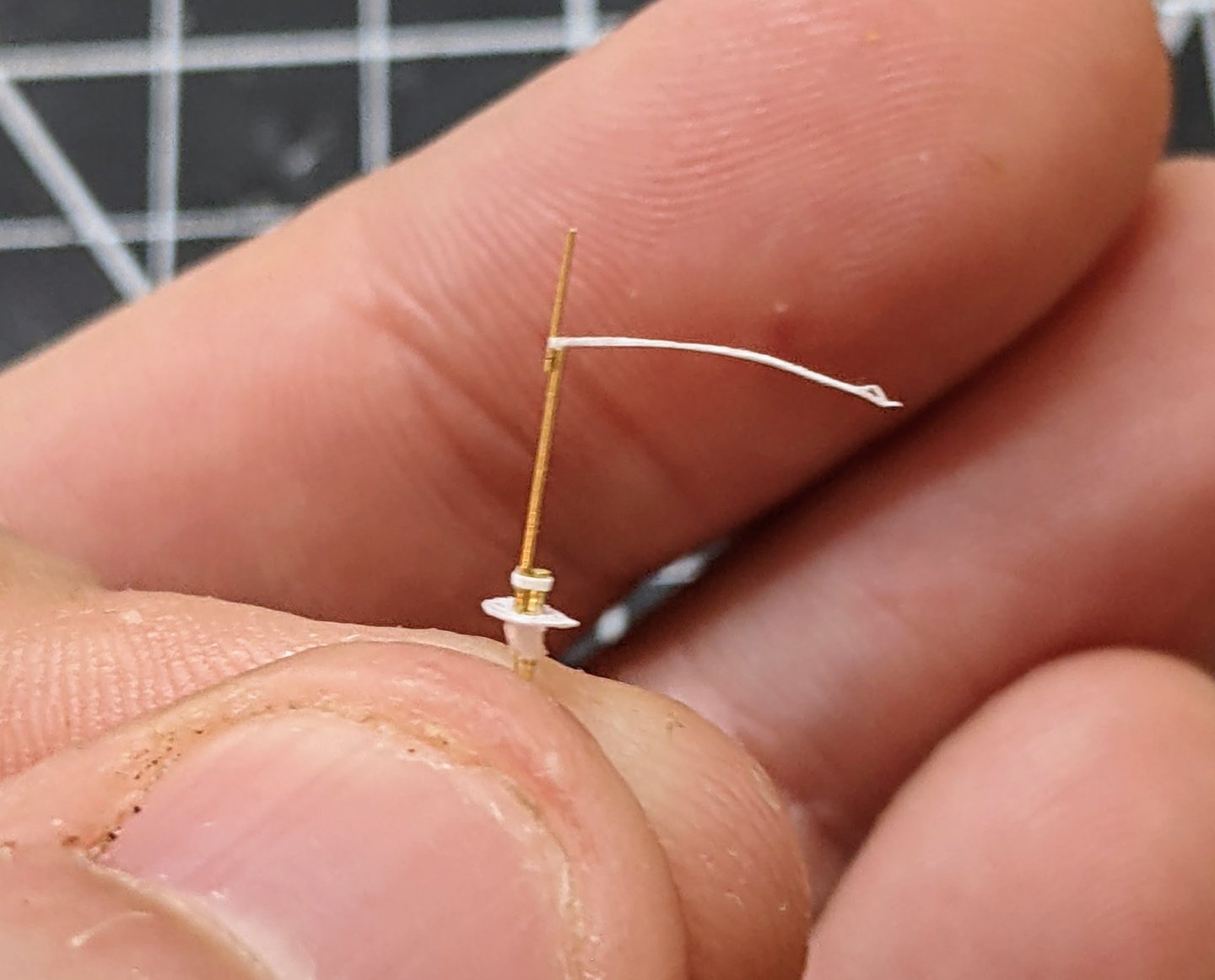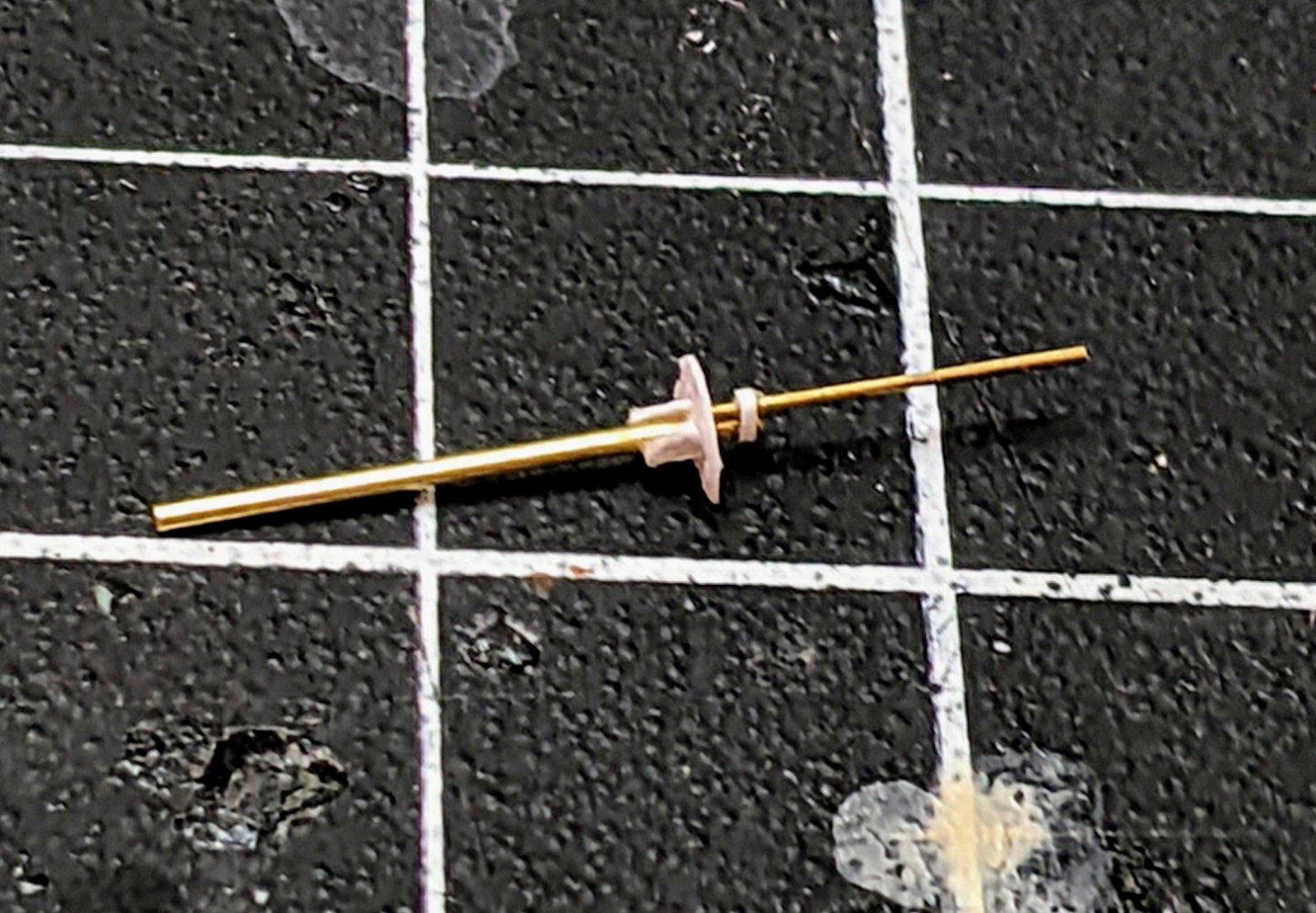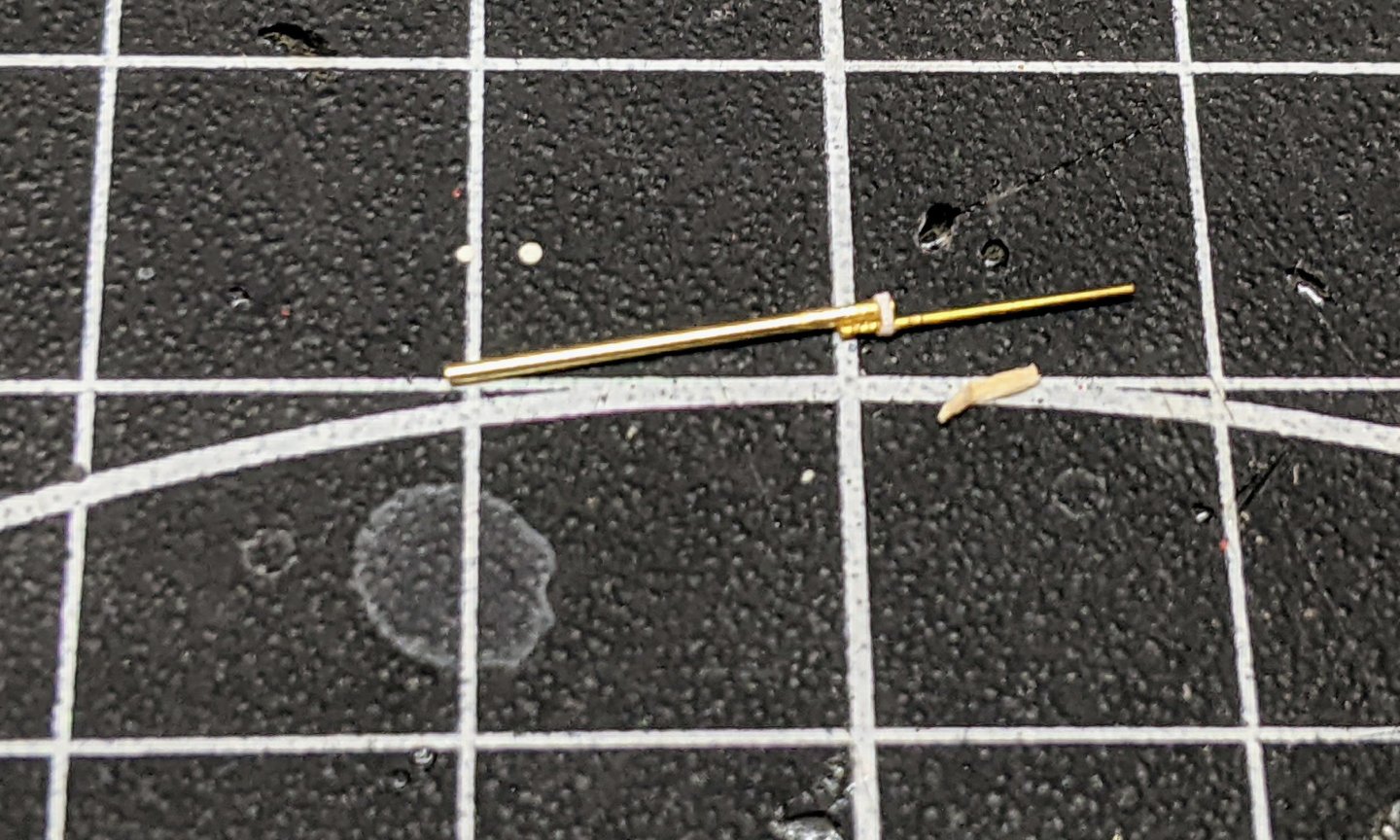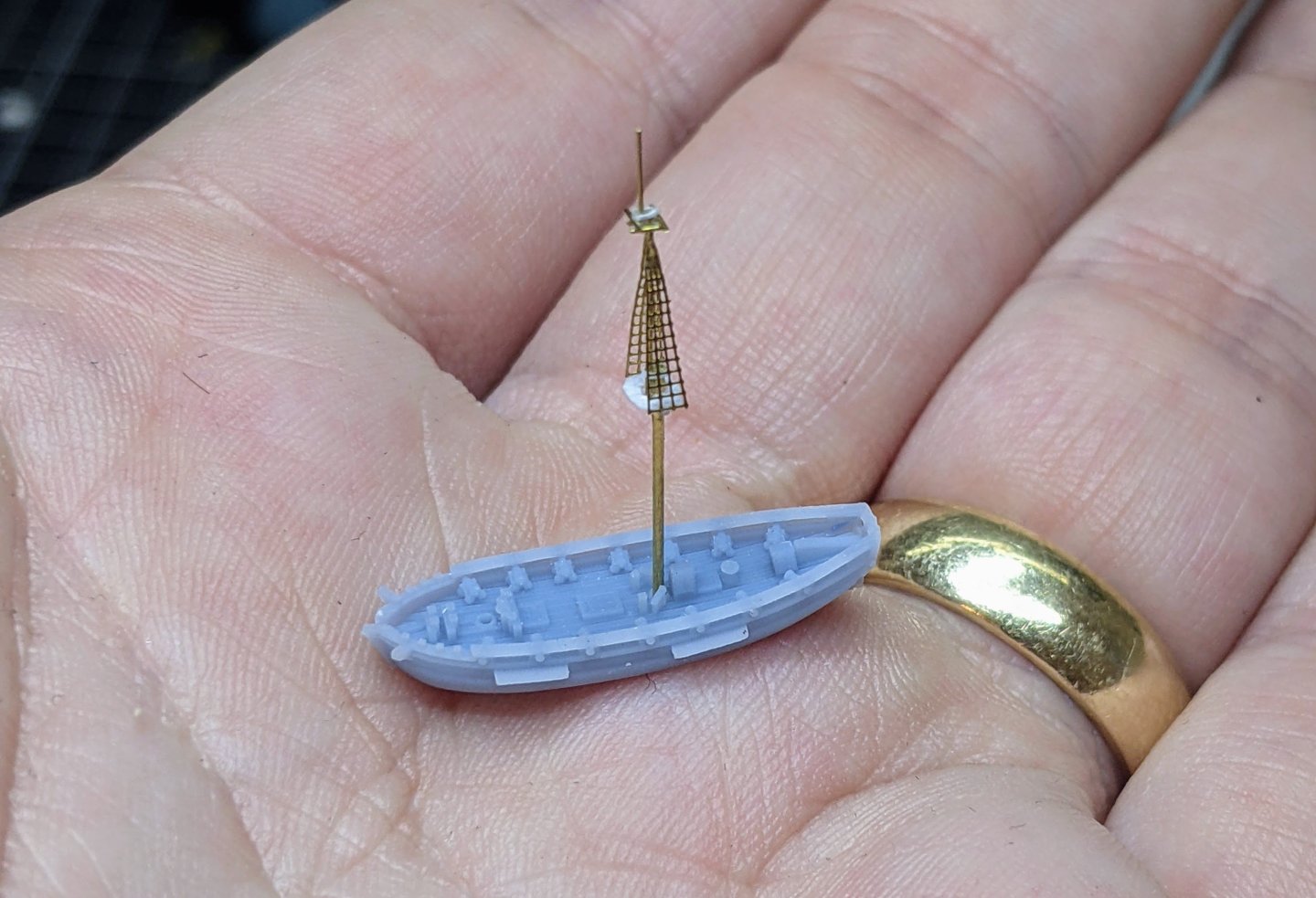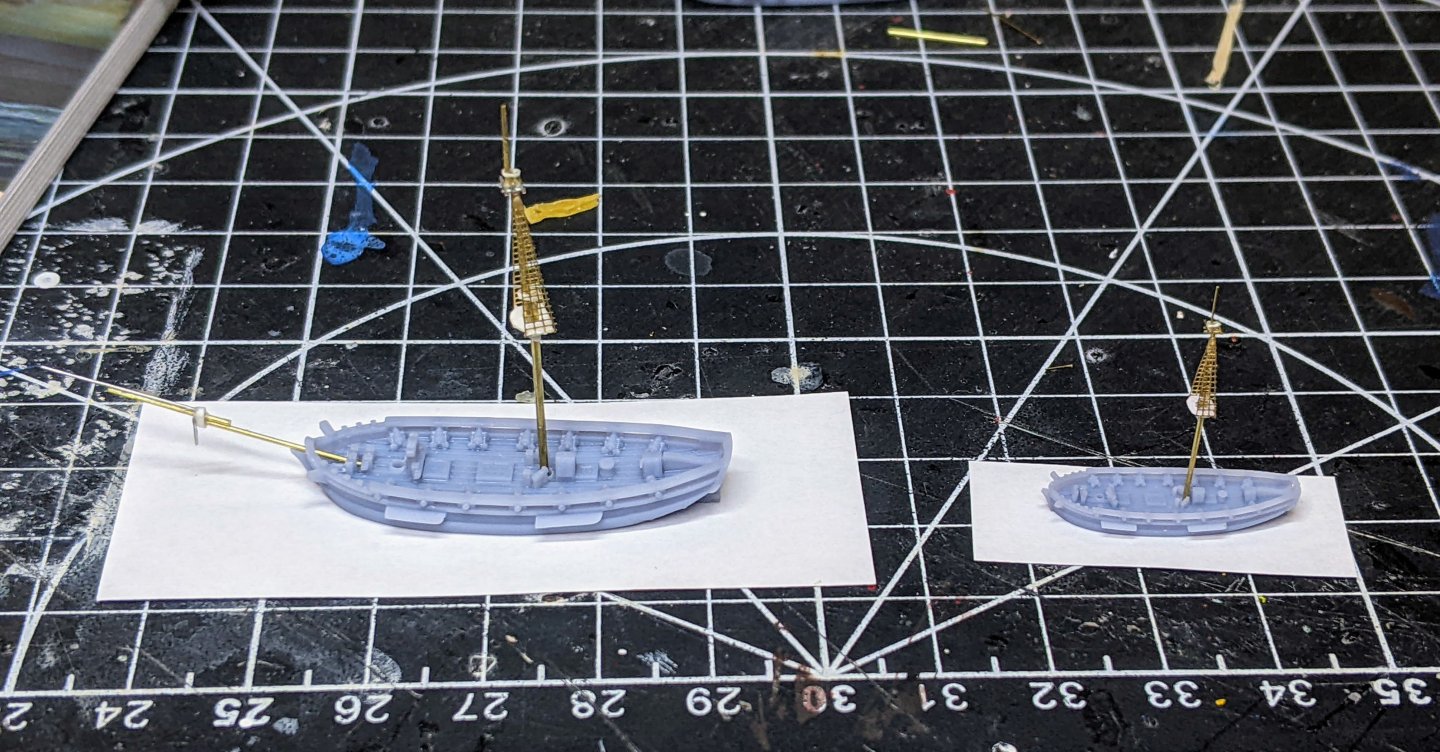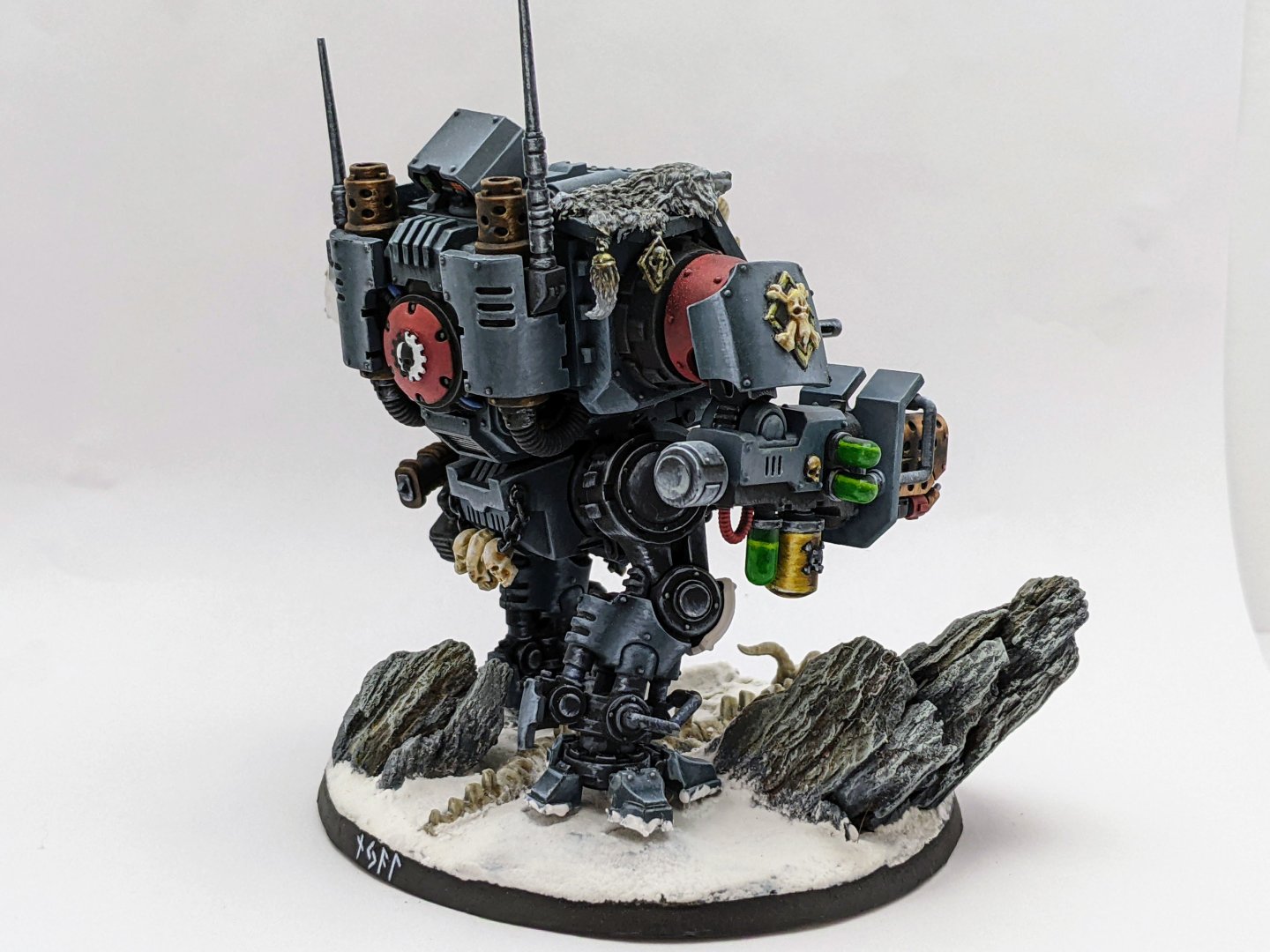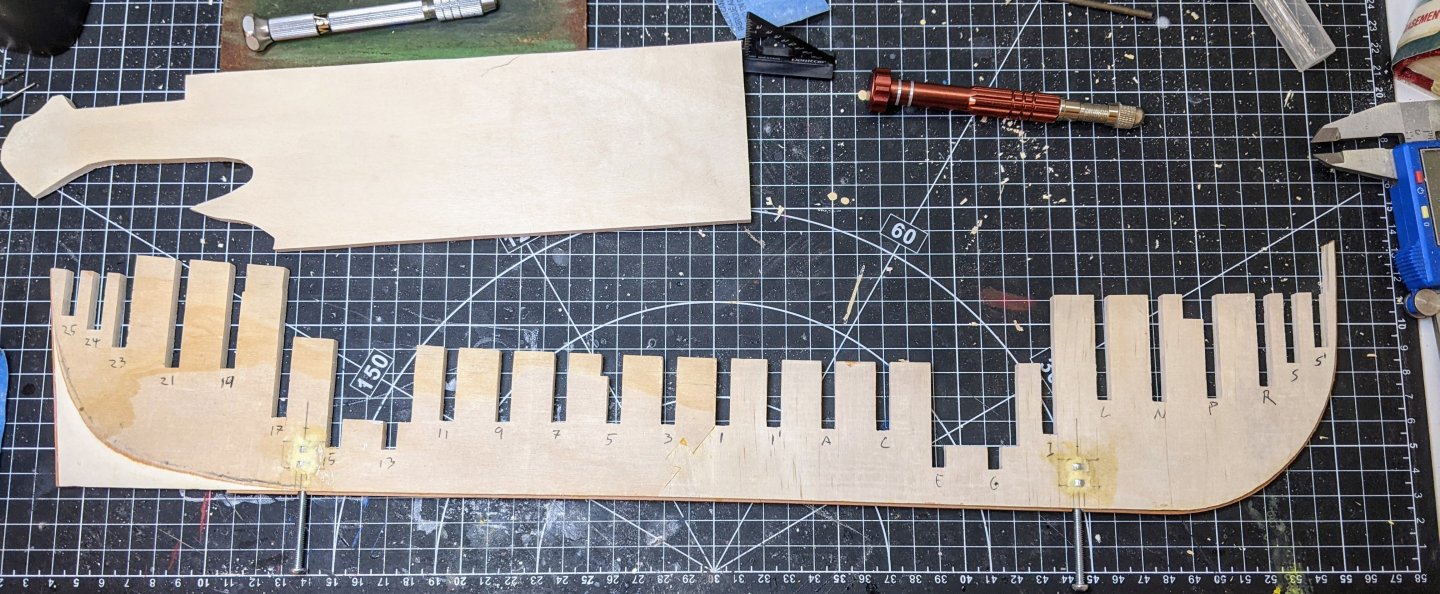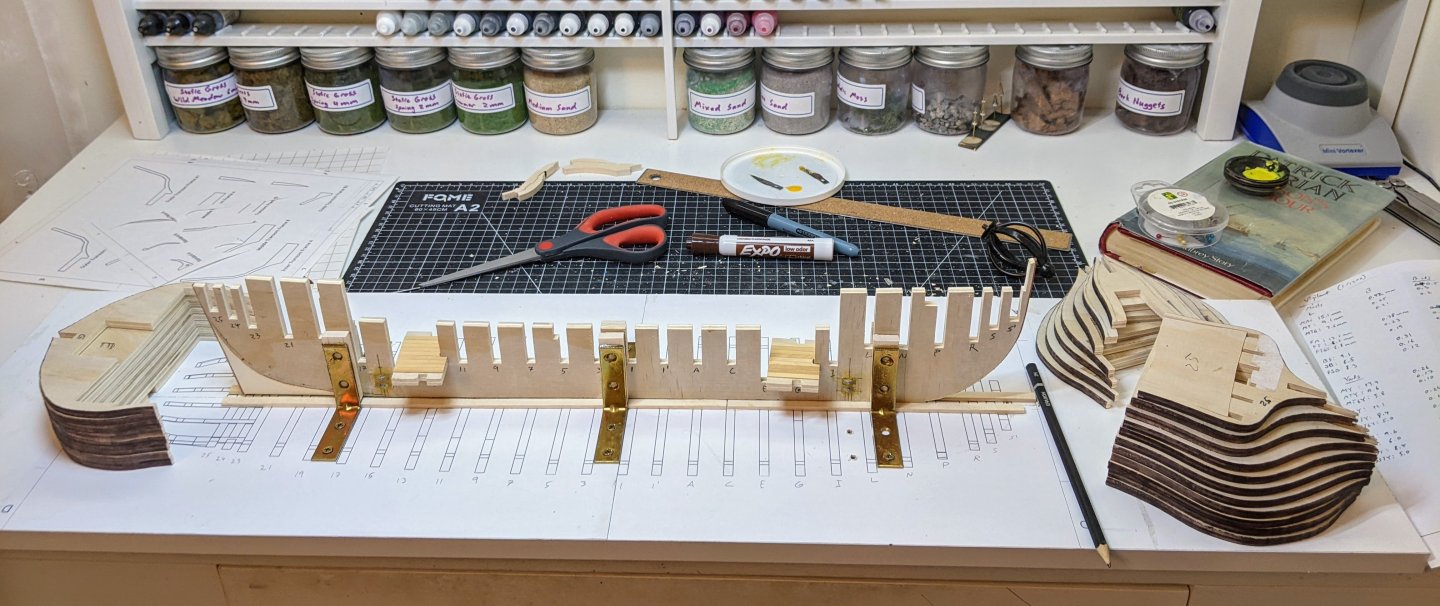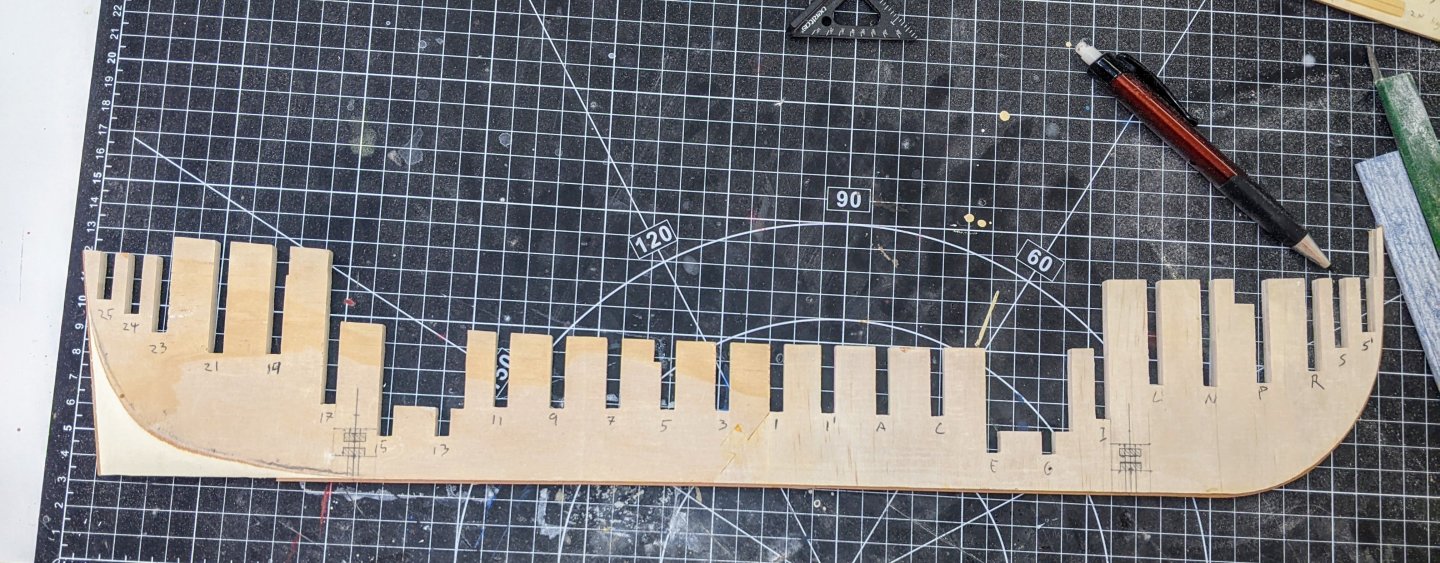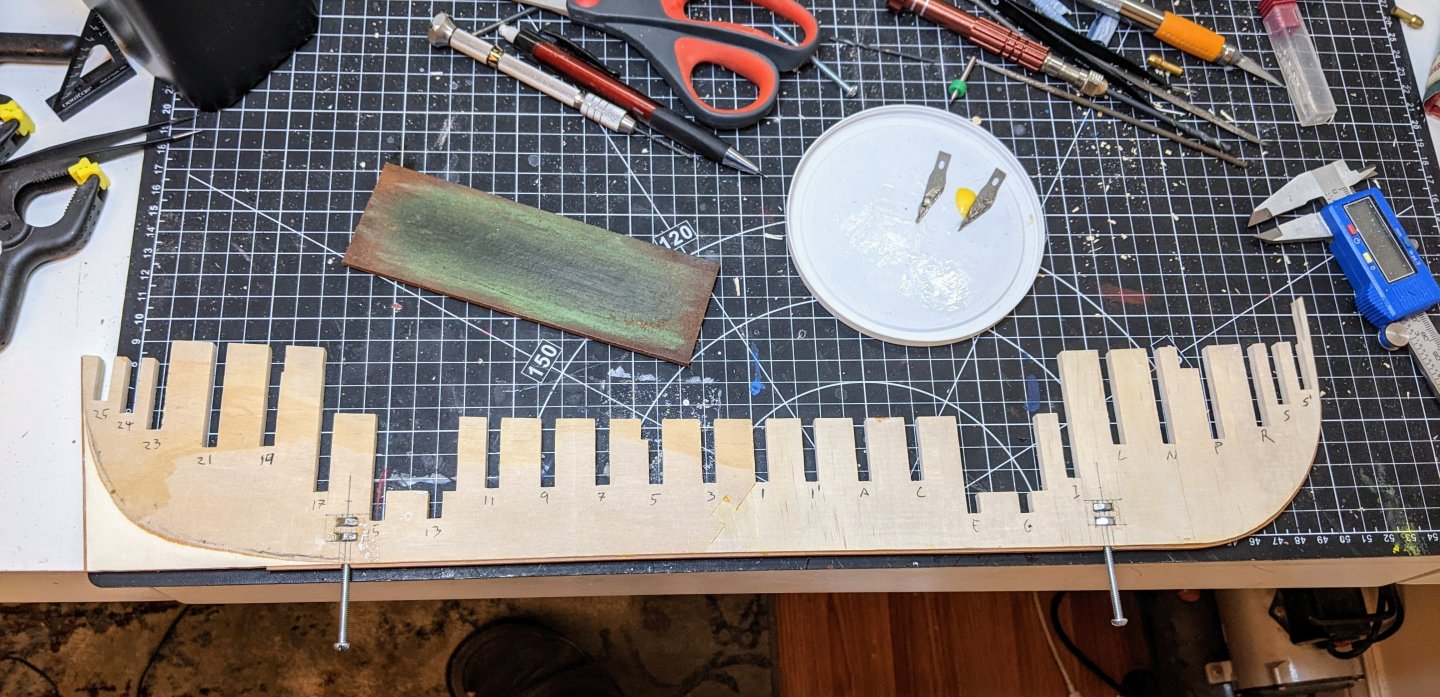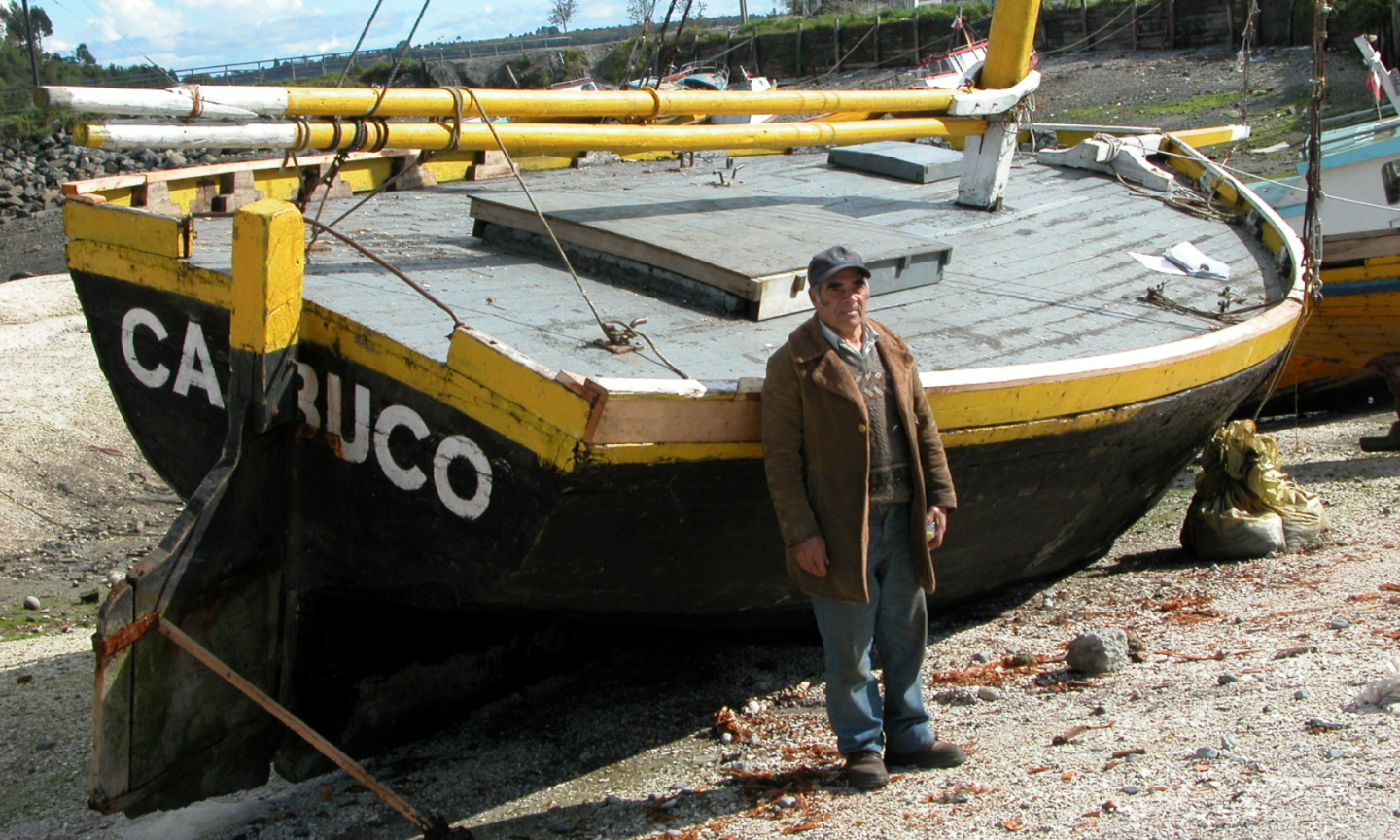-
Posts
1,345 -
Joined
-
Last visited
Content Type
Profiles
Forums
Gallery
Events
Everything posted by Thukydides
-
1/1200 Vigilant Class Brig - Painting Part I To help with the problem of painting something so small I decided to use my airbrush to spray on the deck colour. I found in my 1/700 models that it was actually hard to get a smooth coat for the deck with a brush given the hard to reach areas. You can see that even though they are out of scale, the upper shrouds look fine at a distance. One advantage of painting at this small a scale is you don’t really need to get your placement perfect as at normal viewing distances it will not really be noticeable. I have the base colours down for the hull, but given the small scale very little will be necessary in highlights. Essentially I will be just picking out the upper faces with a lighter version of the base colour. I recently got some dentist loupes off of amazon (the cheap ones). These are a big improvement on my previous magnification glasses, but they take a bit to get used to as they are designed for proper posture (so I don’t need to bend in close), but I have to unlearn all my previous habits regarding where my hands go relative to my face. To give a sense of scale, the squares on the matt are 1cm and the entire base is about 4cm long. Zoomed in this close you can see some of the printing layers, but they are not really visible with the naked eye.
- 39 replies
-
- Black Seas
- wargaming
-
(and 1 more)
Tagged with:
-
I second @wefalck's suggestion. I find template really helpful. I had not noticed you started another build till now. Great job so far and I look forward to seeing her progress.
- 133 replies
-
- ancre
- Bateau de Lanveoc
-
(and 2 more)
Tagged with:
-
That is a clever trick. I will need to remember that one. The ship is looking great. She really is a lovely model.
- 332 replies
-
- Harpy
- Vanguard Models
-
(and 1 more)
Tagged with:
-
Log #19: Beginning the Knee of the Head, Stem and Keel I have begun work on the knee of the head, stem and keel. Step one was to cut the parts out using my scroll saw which I have now found I can be pretty accurate with if I go very slow and use magnification. I also discovered that it is best to glue the pieces as I go. This allows me to adjust the fit of every new piece to match what I had previously cut. As previously indicated, I am gluing the pieces together with a 50-50 mix of heavy body acrylic paint and glue. You can see in the below picture how the glue spills out, but due to it being so thick, it does not stain the surrounding wood. The lines still look a little rough, but that is just due to the fact that even very small discrepancies in the alignment when clamping can lead to the lines looking untidy. Once I start sanding they will look much more neat. You can see how I have used darker glue up to the waterline and white above that. As it is impossible to be super precise with the glue placement, I erred on the side of having dark glue above the waterline as I can always paint in the white line if necessary. I have also cut out most of the other pieces though many of them need final shaping. You can see the current state of affairs below: Once I am done shaping and am sure everything fits properly I will drill the necessary holes. Then I can give thought to sanding and shaping. As I am preparing for final assembly and shaping I have been giving some thought to the thinning of the knee of the head. I have a few questions which I am wondering if anyone is able to help clarify for me. Due to measurements given in the contract I know that the thickness of the knee of the head at point A is 7.5 in (matching the width of the standard which is given in the contract), 15 in at point B (given in the contract), at some point below point C the stem thins to 13 in (the thickness given in the contract “below the hance”) and then finally thins to 11 in at point D matching the width of the keel at the fore end. What I am struggling with is the following: How quickly should the upper stem (part I) thin from 15 in to 13 in below point C? How quickly should the lower stem (part II) thin down to the 11 in given for the keel at the fore end? The thickness of the knee of the head is given at 11.75 in. Where the stem meets it, does it look like option A all the way down until it matches the thickness of the knee of the head, or does it ever become like option B? How thin should I make the leading edge of the knee of the head? There is no indication of the relative ratios in the contract. The fore end of the keel is given at 11 in, does this mean that the leading edge of the gripe would be thinner still?
-
1/1200 Vigilant Class Brig - The Yards My work on the smaller scale continues and today I am going to discuss the yards. Unfortunately I don't have much in the way of pictures because taking them in the middle of building is really difficult at this scale. So instead I am going to use some diagrams to demonstrate and then show a picture of the finished product. First I took a look at some maritime paintings to pick a sail layout. It is important to plan out exactly what you are planning to do as this will impact the position of the yards and we want to produce a coherent model. After cutting the various thicknesses of brass rod to size, I filed a notch in the middle of each yard to help hold it in the right place. For the gaff and the boom, instead of a notch I used a pair of plyers to squeeze flat one end. I then super glued the yards in place and tied them to the mast with 10/0 fly tying thread. Though this is not a perfect solution, I have found that this is the best way (where I don't have access to soldering) to secure them to the mast and better to do it now then have them constantly falling off while painting. As you will see in the final picture, it is not really noticeable. I first do a single knot at the front and then run the thread under the opposite sides of the yards from which it came and do a single knot secured with super glue at the back. Then after it is all dry I cut off the ends with a fresh scalpel blade. For the gaff and boom I used the flattened area which was now a bit wider to tie on with a single knott (and secured with glue) some more 10/0 fly tying thread. The ends of this were then tied around the mast and both the connection and the knot secured with glue. And here is the finished product ready for basing. The masts are only loosely in place as they will be painted separately before being attached once I have finished painting the deck details. I have chosen to depict her broad reach with the wind on her larboard beam.
- 39 replies
-
- Black Seas
- wargaming
-
(and 1 more)
Tagged with:
-
This is a very cool construction method. It is looking like it will turn into quite the model.
-
A bunch of the contracts from the late 18th century mention the lead as well. Fore example here is the wording for Perseus 1776: I am still considering if I want to show the lead or not. We will see. I may just wait till the time comes and see how it matches the aesthetic I am going for. What did you use for the lead, actual lead foil?
-
Looking good. I am also finding courage to start on parts can be a problem. You put all this time into them and practice, but taking the step to start on a finished part feels very dangerous :).
- 92 replies
-
1/1200 Vigilant Class Brigs - Masts Continued I have managed to finish the masts and so figured I would try to show a little more of the construction method. I apologize in advance for the not very good pictures, but it is actually harder to get good in progress pictures at this scale than it is to actually construct the masts. I am going through the fore mast in this particular case, but the process is pretty much the same for the main and the bowsprit. For scale reference, the squares on my mat are 1cm. Step 1 is to cut the necessary lengths from the various brass rods. The lower mast and the topmast are glued together then a thin strip of printing paper was cut and glued around the joint to simulate the mast cap. This also has the effect of greatly strengthening the joint. Next I took some slightly thicker drawing paper I found and cut out the fighting top. This was tacked in place with glue and then the the support structures (I don’t know what they are called) also glued below. Once everything is in the right place I cover all the paper pieces with a thin layer of super glue to strengthen it. Then I move on to the topgallant and glue it onto the topmast. I should note that I find at these small scales that you have to be a bit flexible with the sizes. I only have so many sizes of rod to work with and it is more important that thicker masts look thicker than that they are the exact correct size. So in many cases I adjust the sizes to allow for example the bowsprit to be thicker than the jib which in turn is thicker than the flying jib even if that means scaling up the thickness a bit. The below picture also shows the process of wrapping the paper round the joint to simulate the cap. First I tack then end to the joint and once it has dried I cover the area with glue and wrap the paper around. And here is the current state of affairs. All the masts are done and now I need to move on to the yards. For the fore mast I found a way to get the trestletree to have three pieces sticking out. I just used an off cut piece of the shrouds to simulate the structure. I think it turned out good and will probably use this method going forward.
- 39 replies
-
- Black Seas
- wargaming
-
(and 1 more)
Tagged with:
-
1/1200 Vigilant Class Brigs - Masts I have not posted here in a while as I have been wrestling with a problem I have with my 1/700 models. The issue is that they are probably too big. I have been looking at various rulesets and playing around with the cutter models and have come to the conclusion that ideally I would like to play at a smaller scale to allow for more maneuvering space (given my play area is limited to my dining room table). So this has sent me down a rabbit hole of experimenting at smaller scales. Having got my friend to print a few of the brigs at 1/1200, I have been playing around with how I would go about modelling them. The issues are mostly with the masting and rigging. I am confident that I can handle painting at this scale, but the masting and rigging is less certain. When you go smaller there are some advantages. You can omit some details or approximate them a bit as no-one is going to be able to look closely enough to notice. So after playing around a bit I cot some more sizes of brass rod and made a test mainmast. You can see here that the model has printed well and that all the detail is visible. The mainmast is made with 0.5mm brass rod. It really should be 0.4mm given the scale, but I wanted to give it a bit more strength and accentuate the size difference between the lower mast and the topmast. I used paper for the fighting top strengthened with superglue to hold it rigid. The mast caps were again wrapped with paper as I couldn’t think of a better approximation at scale. Though they are probably a bit oversized this will accentuate them when we come time to paint. The trestletree had to be approximated with only 2 cross pieces (as opposed the the three it should have). The shrouds gave me a fair bit of pause. There are no good aftermarket versions available for 1/1200 scale and I did also consider simply using thread and omitting the ratlins. But in the end for both structural reasons (this holds everything rigid) and also ease (trying to get thread in the right place felt like it would be too difficult), I decided to go with my 1/600 shrouds I have. Though they are oversized, from normal viewing distances they actually look fine. In some ways the oversized nature helps to see the detail. I also have some plans when it comes to painting to simulate the deadeyes and lanyards. You can see below how much smaller this scale is compared to 1/700. Though it is about half the size in length, in terms of area is is about 1/4 of the size. You can also see how much smaller a potential base size is giving much more room to maneuver on the table. The 1/700 version is about the size of a large frigate at 1/1200 scale. So that is all I have for the moment. I am going to build the foremast and the bowsprit next and once that is done I will move on to the yards.
- 39 replies
-
- Black Seas
- wargaming
-
(and 1 more)
Tagged with:
-
Thanks, Not much to see with the materials. From left to right they are various static grass, various sands (light to course), rocks and fake moss, cork, bark. The bark does a good job of simulating rocks for miniature bases. For example see the below model. The model pieces you can see in the background are masts for my small scale Napoleonic ship miniatures project. You can find a link to a build log in my signature.
-
Congrats on a lovely model.
- 62 replies
-
- prince de neufchatel
- model shipways
-
(and 1 more)
Tagged with:
-

HMS ANSON 1781 by albert - 1/48 - 64 guns
Thukydides replied to albert's topic in - Build logs for subjects built 1751 - 1800
Amazing work. -
I enjoy these SIB builds. It is a very striking subject.
- 106 replies
-
- Kentoshi-Sen
- bottle
-
(and 1 more)
Tagged with:
-
Log #18: Securing the Model I am waiting on getting some new magnification this week to help with the cutting of the knee of the head. So in the meantime I am continuing work on the structure of the model. The last piece of work that needs to be done before the structure is ready to assemble is the hardware for securing the model to its base. I came up with a relatively simple solution for this. Frist I marked the location for holes to be drilled in the bottom of the bulkhead and where the slots for the nuts would need to be cut out. These needed to be sufficiently high so the nuts do not stick out wider than the bulkheads at that point, but also not so high that the screw has sufficient clearance to allow for the supports and the thickness of the base. You may also notice that I thinned the stern of the center bulkhead as this is easier to do now than later. It may need a little more adjustment later, but the bulk of the material has been removed. I then carefully cut the slots with chisels a little wider than necessary to allow for some movement of the bolts to make sure the threads align. I drilled the holes with a pin vice starting with a very small drill bit and slowly increasing the size. As it is hard to drill perfectly straight, the last little bit had to be widened with a round file to make sure that the holes were centered and straight. I also found that clamps on either side of the bulkhead helped while drilling to prevent the drill bit accidentally tearing out the sides of the hole. I then used some epoxy to secure the bolts in place making sure the screw could freely turn in them. Once the epoxy was dry I covered the whole area with a thick sawdust and wood glue mix to make sure all the gaps were filled. I may strengthen this area further once all the bulkheads are in place. With the bolts in place I used a marker to darken the sides of all the bulkheads. This will allow me to better judge how much I have fared them when it comes time to do that. So here is the current state of affairs. Next step is to finish the keel / knee of the head and secure them to the center bulkhead.
-
Nice buoys. They are really fiddly to make.
- 114 replies
-
- Vanguard Models
- Speedy
-
(and 1 more)
Tagged with:
-

Linus Napoleonic shipyard
Thukydides replied to Linus Spjutsberg's topic in New member Introductions
I have also been planning on picking up captaincy as it really has by far the most interesting sailing system I have seen. I have read through and played around with enterprize, their free version of the 1.0 rules. I am currently experimenting with making 1/1200 models to see how viable that would be to allow more space for sailing maneuvers. -
Aesthetically I feel like it needs a bit more taper near the end, but I was looking back through your reference photos and the below one doesn’t seem to have much taper. Also it looks a little bent so I think any imperfections in the symmetry of the model boom probably only add to the realism. In any case she is looking really good.
- 312 replies
-
- Chile
- Latin America
-
(and 6 more)
Tagged with:
-

USS Constitution by mtbediz - 1:76
Thukydides replied to mtbediz's topic in - Build logs for subjects built 1751 - 1800
It is looking really good.
About us
Modelshipworld - Advancing Ship Modeling through Research
SSL Secured
Your security is important for us so this Website is SSL-Secured
NRG Mailing Address
Nautical Research Guild
237 South Lincoln Street
Westmont IL, 60559-1917
Model Ship World ® and the MSW logo are Registered Trademarks, and belong to the Nautical Research Guild (United States Patent and Trademark Office: No. 6,929,264 & No. 6,929,274, registered Dec. 20, 2022)
Helpful Links
About the NRG
If you enjoy building ship models that are historically accurate as well as beautiful, then The Nautical Research Guild (NRG) is just right for you.
The Guild is a non-profit educational organization whose mission is to “Advance Ship Modeling Through Research”. We provide support to our members in their efforts to raise the quality of their model ships.
The Nautical Research Guild has published our world-renowned quarterly magazine, The Nautical Research Journal, since 1955. The pages of the Journal are full of articles by accomplished ship modelers who show you how they create those exquisite details on their models, and by maritime historians who show you the correct details to build. The Journal is available in both print and digital editions. Go to the NRG web site (www.thenrg.org) to download a complimentary digital copy of the Journal. The NRG also publishes plan sets, books and compilations of back issues of the Journal and the former Ships in Scale and Model Ship Builder magazines.

